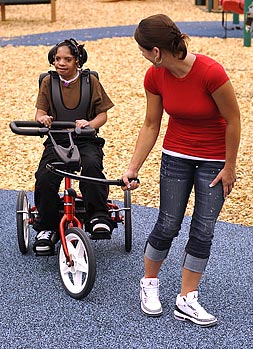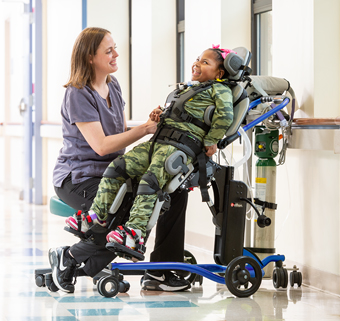NuStep, II Step, Let's do the III Step!
How can current theory and research evidence impact our physical therapy practice and interventions?
| June 2008
In 2005, 600 leading physical therapists convened with the goal of educating present and future physical therapists to develop and practice more effective clinical interventions. The conference, known as III STEP ("Three-Step"), focused on current research findings in movement science.
Current discoveries in motor learning, motor control, and neuroplasticity have resulted in new knowledge superseding earlier theories and models of intervention. Leaders in the field are now using terms such as "translation of movement science into effective intervention," "repetitive practice of problematic motor abilities in meaningful environments," "activities and participation," and "physical therapy to promote functional skills, individualized to child/parent goals."
Meeting from July 15-21, 2005 in Salt Lake City, UT, III STEP participants shaped future trends of the physical therapy profession in Pediatrics and Neurology
"III STEP speakers, reflecting a diversity of research and clinical backgrounds, collaborated with participants to consider basic science principles of neural plasticity, learning and adaptation, and the application of innovations in current research to future clinical practice and movement science research endeavors."
But let’s step back a moment for the history on this. Not to confuse anybody, but there have been three ‘STEP’ conferences since the development of the physical therapy profession. (That’s why the last one was called III STEP — get it?) Each one has facilitated significant change in the education of physical therapists and physical therapist practice throughout the world.
So . . . first it was I STEP, right? Nope. First it was NUSTEP.
(Northwestern University Special Therapeutic Exercise Project
Chicago, IL, 1966)
Then it was II STEP.
(Symposium on Therapeutic Exercise Proceedings, or: Symposium on Translating Evidence into Practice in Norman, OK, 1990)
And then it was III STEP!
(Symposium on Translating Theory into Effective Practice,
or: Summer Institute on Translating Evidence into Practice in Salt Lake City, UT, 2005)
After III STEP, the APTA provided regional follow-up conferences. Following are a few brief summaries of concepts discussed, such as the ICF, motor learning, and neuroplasticity.
Models of Rehabilitation and the ICF
Many practitioners are familiar with the Nagi Model of Disablement (1965, 1991) which has four levels, described as Pathology, Impairment, Functional Limitation, and Disability. The current shift is to a more all-inclusive framework for evaluation and intervention, known as the International Classification of Function (ICF).
The ICF, established in 2001, is actually a more recent version of the World Health Organization's ICIDH model, the International Classification of Impairment, Disabilities, and Handicaps. The ICF, as the most current conceptual framework for health, is now being applied to rehabilitation throughout the world. The APTA House of Delegates officially endorsed the ICF in June 2008.
What is unique about the ICF is that it approaches everything from a participation perspective. The actual function of the person in daily life is paramount. The ICF stresses health in the presence of disability and does not see disability as only a medical or biological dysfunction. Any person's situation can be described by this framework, wherever they may be along the health continuum. The emphasis changes from a deficit to enablement perspective, shifting the focus from cause to outcome. Because the ICF includes the environment, the scope for function — and for intervention — is dramatically impacted.
Learn more about the ICF on the World Health Organization’s web site.
Download an ICF Checklist pdf.
So why is this significant? The ICF has three levels: Participation, Activity, and Body Functions and Structures. Historically, physical therapists have been excellent at applying their practice at the Body Functions and Structures level. With the ICF, leading–edge physical therapists are bringing the focus to Activity and Participation. This change in perspective has led to more attention on task–specific functional gains, independence, outcomes, and compensatory skills. All of this is facilitated through motor learning and practice!
The areas of participation, motor learning, and motor control practice are where adaptive equipment can play a significant role both as an accommodation and as an intervention, particularly in school–based physical therapy practice.
Motor Learning
Further concepts emphasized at III STEP include development of skills, skill retention, transfer and generalization, and task–oriented therapy. Skill is defined as the ability to consistently, flexibly, and efficiently achieve a desired outcome. Task is defined as the goal–oriented, learner–challenging, adaptable, fundamental unit of therapy.
There is a direct connection between the functional use of a task, and the amount of practice and skill acquisition/retention that happens during motor learning. Increasing evidence points toward the importance of numerous occasions for practice. Evidence also supports: practice in a natural environment (not a clinical one), practice that provides the greatest amount of challenge while still allowing skill acquisition (as occurs with prompt reduction), and practice of tasks/skill subsets that are important to the learner.
Neuroplasticity
Neuroplasticity is one of the fundamental issues underlying rehabilitation. Through practice and with novelty and challenge, the brain can make more efficient use of its resources. Unfortunately for all of us, the reverse is also true! Essentially we all have neuroplastic ability; it is this same concept which has fueled the interest in the "use it or lose it" phenomenon in the elderly.
So – what do you think about neuroplasticity in physical therapy: Are we looking at compensation or at recovery?
In fact, we’re looking at both.
Let’s think about what is actually happening: Learning a new and challenging skill places a demand on the brain at the molecular level. The brain reorganizes itself through the creation of new synapses and new capillaries, and the chain of compensation continues from there. The result is an eventual improvement in skill performance.
Now let’s consider neuroplasticity and the question of compensation vs. recovery, from the perspective of the ICF. If we begin at a structural level (body functions and structures), the neuroplasticity that is occurring within the brain underlies compensation. At an activity or participation level, this same compensation underlies recovery: what is actually happening is structural compensation and with that, a recovery of function, or as the ICF would say "participation."
Until the last decade, most of the neuroplasticity research available was performed using an animal model, measuring electrical activity in the brain. Now, through functional MRI and other means, researchers are able to do similar research on humans, measuring local blood flow rather than electrical activity. The implication for the rehabilitation field is the unequivocal proof that achieved motor gains are greater than just teaching compensation skills following a natural course of recovery.
Evidence–based Practice
Physical Therapy intervention based on research evidence is no longer an issue that is solely of interest to the clinician and patient. Research evidence will affect manufacturers as well, as payers are requiring scientific evidence to support intervention strategies and positive outcomes for patients. This is partly what has spurred the creation of Position Papers by such organizations as RESNA.
For example, consider the long held notion that standing is good for bone health. Scientific studies show that it is bone loading and muscle tensile forces that result in the cellular level activity that increases bone density. Yet what frequently happens with therapeutic standing in practice is passive positioning. This example highlights the importance of furthering basic science research into studies using clinical trials. This is a call for manufacturers, clinicians, and researchers to collaborate more in the future.
Conclusion
III STEP was a significant meeting of leading scientists and practicing health professionals from various backgrounds, particularly relating to neuroscience and pediatrics. The goal of III STEP was to more effectively link current research in movement science to intervention in professional practice. The 2005 Conference included panel discussions, poster sessions, ongoing dialogue and collaboration that were invaluable; it will require the continued commitment from physical therapists worldwide to further their knowledge and understanding of the topics covered, and to apply these evidenced–based practices to patient care.




